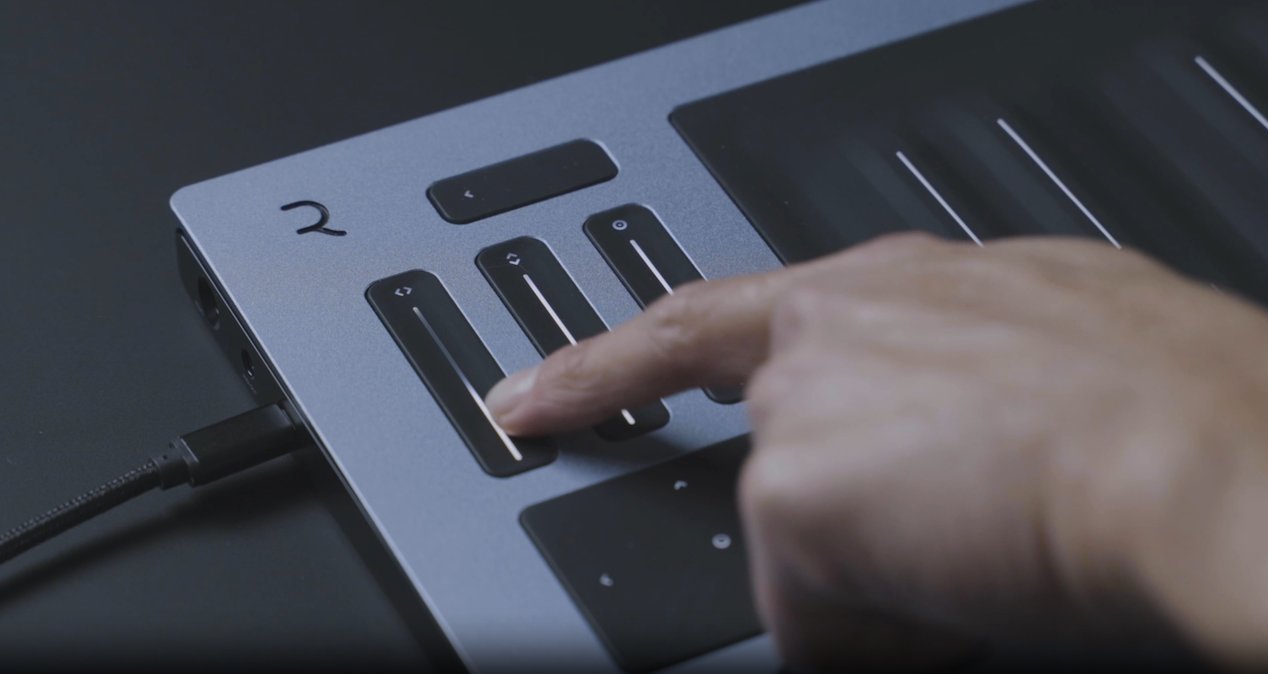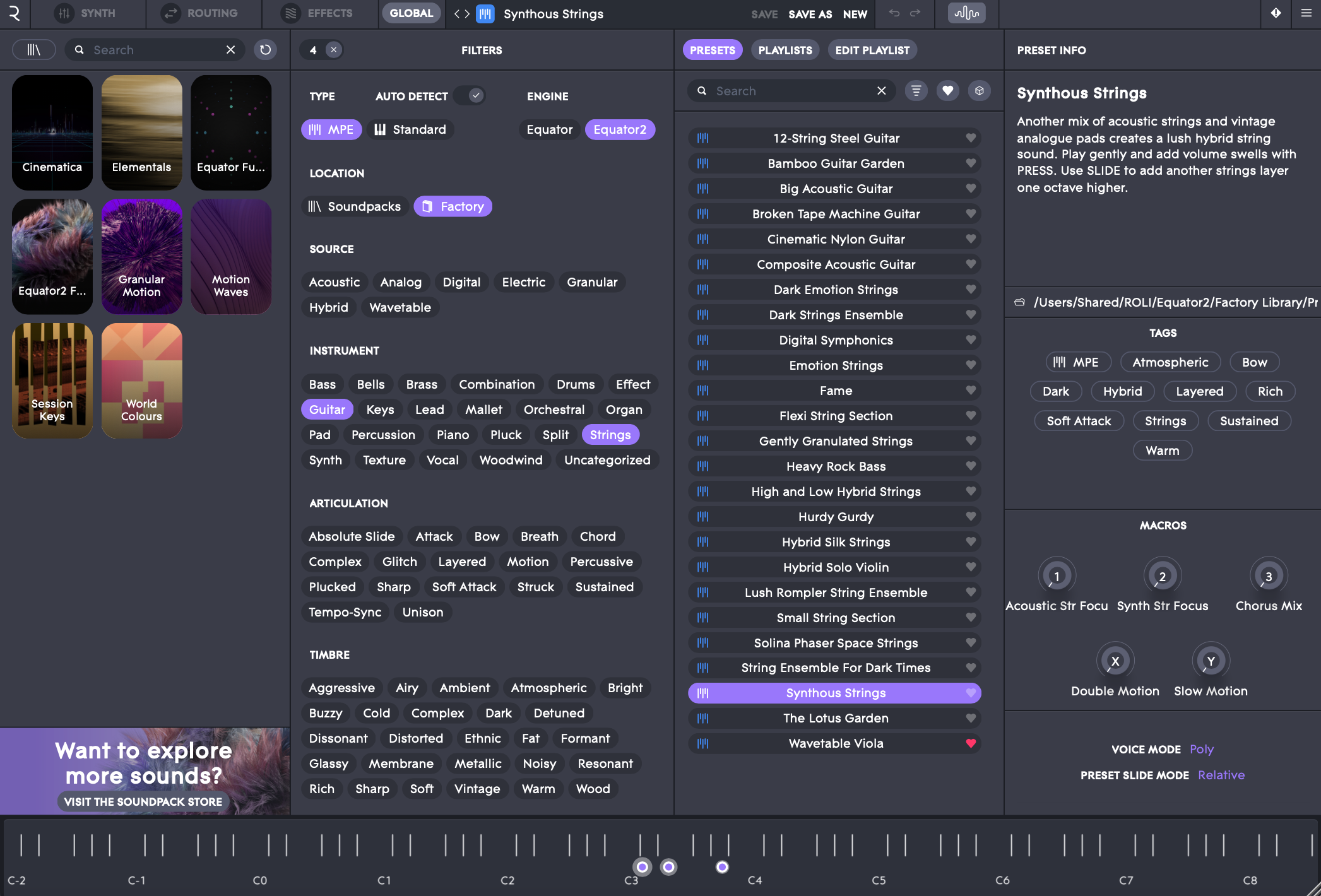How to get started with the Seaboard RISE 2 as a strings player
Whether you're a guitar, violin or bass player — or just curious — we've created a guide to leverage your strings skills with the RISE 2's incredible 5 Dimensions of Touch and Equator2's powerful instrumental sounds.
Exploring the Seaboard RISE 2 for the first time is bound to be a different experience for everyone. Factors such as your primary instrument, previous music-making workflows, and simple muscle memory can vastly change the learning curve with an MPE instrument of this kind. This learning curve, however, can be used to your advantage. In fact, the unexpected nature of the Seaboard, from its playing surface to its expressive features, is exactly why it’s such a powerful instrument to experiment with.
For those of us who come from an instrumentalist background, specifically playing stringed instruments, we’re pretty familiar with the tactile nature of our playing. The connection you feel to your own creativity through the wood, metal, and other hardware elements of your instrument is essential to your expression. You might even be afraid of losing that when picking up an MPE instrument.
In this article, we’re learning all about how we can hold on to that connection with RISE 2. We’ll walk you through ways to learn, express yourself, and even honor your other instruments through the Seaboard. With or without frets, electric or acoustic, classical or experimental, you hold distinct advantages in your hands, ears, and soul. Let’s use them and get creating.
Leveraging your existing skills when starting with a Seaboard
So what are some examples of advantages you might hold when sitting in front of a Seaboard? If you’re reading this as a classical pianist, it’s likely that you hold a distinct benefit of hand and body positioning. You can sight-read traditional Western sheet music and have compositions that are immediately translatable to a piano-like surface. If your expertise lies in wind instrumentation, you share in sheet music familiarity but perhaps have a different approach to expressiveness and dynamics. Getting the most out of your instrument, and pushing its boundaries is an ever-lasting discipline.
If you’re an in-the-box producer, you’re likely very comfortable with playing software synthesizers through 24+ key controllers. You’re a MIDI mapping expert just as excited by capturing an initial idea as you are manipulating it through effects, signal processing, and modulation.
Of course, in today’s ever-expanding landscape of music-making methods, you likely do not consider yourself any one kind of creator. Whatever your background, understanding how to leverage existing strengths as a creator along with the skills you’re hoping to develop through your Seaboard RISE 2 will help you make the most of the instrument.
Guide for string players
This piece is speaking to those of you who come from an instrumentalist background, specifically playing stringed instruments. You crave the tactile nature of your playing. The connection you feel to your own creativity through the wood, metal, and other hardware elements of your instrument is essential to your expression. You might even be afraid of losing that when picking up an MPE instrument.
Step 1: Understand the playing surface
The ‘squishy’ black silicon surface of the Seaboard is what allows for the expressivity of the instrument. 49 continuous keys, also referred to as Keywave 2, are only separated by subtle changes in height as well as precision frets. These are subtle ridges that can allow for more accurate playing and are a small but crucial addition to the RISE 2.
With 5 Dimensions of Touch high dynamic performance is made possible with intuitive physical connection with the instrument. You can learn more about each of these touch methods in this video by producer Taetro.
This is one place where string players can feel more at home, and excited about learning to play with a Seaboard. Through the Strike and Press gestures, the intensity of individual notes can be leveraged much how one can with a bow, pick, or finger.
NOTE: It’s important to take special care of your playing style if you have long nails for classical guitar, banjo, etc. We recommend ensuring nails are well maintained (not too sharp or long) and you play mindfully to avoid damaging the Seaboard’s surface.
The Precision Frets are one of the most notable differences with the second iteration of the Seaboard in terms of the physical look and feel. Based on Creator feedback, we decided to add these small ridges to the Seaboard’s surface to enable more accurate playing. This is particularly important to players in darker settings, as is often the case while performing. It’s also helpful for the spaces of the traditional black keys (C#, D#, F#, G#, A#) which have a lighter-colored fret for easier visibility.
To take a moment to review these words for acoustic instruments:
A fret on a stringed instrument will effectively lock each note in its place. The metal brace creates a chromatic set of notes dependent on the length between each of them. Players of these instruments express vibrato through bending a string up or down, slightly altering the length of the string resonating between bridge and fret. The bend is actually tightening the string, momentarily, as one does by tightening the string to a new, fixed position with tuning pegs.
Fretless stringed instruments allow for vibrato to be expressed through moving the finger further across the neck, rather than bending the string. This also means such instruments have a wider range of chromatic possibilities without the need of string bending.
Now, you likely know the above, but establishing this difference is important to understand the following: the precision frets on your Seaboard have the feel of frets as a thin, raised ridge, but the functionality of a fretless instrument as vibrato is achieved through slight movements left and right. So long as the Slide touch dimension is activated, the tactile approach to sliding notes as well as pitch bending will align with fretless instrumentation. You can adjust the intensity of the Slide dimension here:

This, as well as the two sliders to the right, the XY pad, and a foot pedal if you have one, can all be re-assigned via MIDI mapping in your DAW.
If Slide is deactivated, this will create a more regimented, chromatic playing experience like that of your fretted instrument. Pitch bending can still be altered independently.
Step 2: Explore sounds
The Seaboard RISE 2 comes with over 1,400 presets, usable via our soft synth Equator2. The ROLI Studio Player may also be used for sound exploration as a standalone desktop app or within most DAWs.
We see two paths from here. The first is to build your comfort with the instrument through new timbres, such as pads or basses. If you go this route, we recommend beginning with the Unison Chord Pluck, Slow Wavetable Sweeper Pad, Pure Super Jupiter Pad or Incha Bass Equator2 presets. You have plenty to choose from, and you can adjust settings from each preset to make them your own.
Alternatively, and the method we will primarily continue exploring in this article, you may begin with sounds emulating your own instrument(s). This will differ greatly depending on the register, string composition, and gear you may use with your stringed instrument, though really any string preset should trigger some level of familiarity as you play. Consider starting with the Yanguin Doubled, Sitar, or Nylon Guitar in a Golden Room or Antiquity Lute presets.
Within Studio Player, you can search and/or filter through all presets available to you. If you were to do so for ‘strings’ and ‘guitar’ you will see results such as this:

If you aren’t finding what you like, this may be the time to build your own preset, in particular, if you have experience in synthesis. There’s always the option of picking up a new sound pack, such as Orchestral Ensembles or Granular Foley from our Sounds store.
Step 3: Re-learn your favorite riffs and chords
It’s very natural for string players to return to their favorite phrasings, chord progressions, and solo licks. If you’re like me, there are a few key intervals (like a sixth) that I crave to hit often. Something about it just clicks with my ear, and therefore they often make it into my compositions.
So this is your challenge: look back on your favorite pieces of writing on your stringed instrument. Pull out your Seaboard, pick a preset you like, and re-learn it. From here, you can record it and test out how it sounds across other presets. If you stick with the exact same tempo and phrasing, maybe you double it with the original part and see if it can fit into a song. The main purpose is to gain stronger familiarity with the instrument, and doing so with music that your ear is used to hearing is a great way to let your body catch up.
Hear how I did with a playful, descending chord progression in C# minor. The original:
<iframe width="100%" height="20" scrolling="no" frameborder="no" allow="autoplay" src="https://w.soundcloud.com/player/?url=https%3A//api.soundcloud.com/tracks/1628398374%3Fsecret_token%3Ds-fA3MnjGBW8w&color=%23171717&inverse=false&auto_play=false&show_user=true"></iframe>
And on the Seaboard, using the oh-so-spacial Crystal EP MPE preset:
<iframe width="100%" height="20" scrolling="no" frameborder="no" allow="autoplay" src="https://w.soundcloud.com/player/?url=https%3A//api.soundcloud.com/tracks/1628400633%3Fsecret_token%3Ds-9xNkQkGD0ka&color=%23171717&inverse=false&auto_play=false&show_user=true"></iframe> <
Step 4: Compose expressively, and bring that back to your instrument
Conversely, you can do what most people start with: pull out the Seaboard, set it up and clean it if needed, pick a preset and begin experimenting. Try to come up with a few ideas that have melodic potential, even if it’s only a few notes. Follow the rabbit hole as long as it feels right to you, whether you hop into your DAW or not, but be patient. It may take a bit of time, especially if you have not undertaken any formal piano training.
Once you have something you’re happy with, learn it on your stringed instrument. See how the phrasing feels for something that was written on your new instrument. Do all of the chord phrasings work? Do you have enough octave range? What feels the same, and different?
Step 5: Learn your favorite songs on the Seaboard
Since its first release, the Seaboard has been used for amazing cover renditions of all music genres. We previously featured a number of those here. Your task is to attempt to do so for your favorite tracks with your stringed instrument.
Below are just a few suggestions at a range of skill levels. In particular for instruments like bass which tend to play single-note patterns, you may also try to play some other voices your ear can pick out in the track.
If you are a guitar player
If you are a violin player
If you are a bass player
Want more inspiration? We recently featured Sam Gutman, who grew up playing metal guitar among other genres before trying the Seaboard. Fast forward to today, touring with Ms. Lauryn Hill, you can learn about his experience and advice here.
The author
Matt Brooks is an event producer, musician and poet based in Berlin. The grandson of jazz musicians in 1940s Chicago, music was ever-present, permeating the fondest of memories that would shape his life and career.
Join the ROLI community